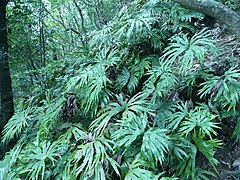Gleicheniales: Difference between revisions
m WP:CHECKWIKI error fix for #61. Punctuation goes before References. Do general fixes if a problem exists. - using AWB (9866) |
Cyberbot II (talk | contribs) Rescuing 1 sources and tagging 0 as dead. #IABot |
||
| Line 38: | Line 38: | ||
==References== |
==References== |
||
{{commons category}} |
{{commons category}} |
||
* {{aut|Smith, A. R.; Pryer, Kathleen M.; Schuettpelz, E.; Korall, P.; Schneider, H. & Wolf, P.G.}} (2006): A classification for extant ferns. ''Taxon'' '''55'''(3): 705-731. [http://www.pryerlab.net/publication/fichier749.pdf PDF fulltext] |
* {{aut|Smith, A. R.; Pryer, Kathleen M.; Schuettpelz, E.; Korall, P.; Schneider, H. & Wolf, P.G.}} (2006): A classification for extant ferns. ''Taxon'' '''55'''(3): 705-731. [https://web.archive.org/web/20080226232147/http://www.pryerlab.net/publication/fichier749.pdf PDF fulltext] |
||
[[Category:Gleicheniales]] |
[[Category:Gleicheniales]] |
||
Revision as of 23:50, 1 July 2016
- This article defines the Gleicheniales in a loose sense. For the restricted definition, see Gleicheniaceae.
| Gleicheniales | |
|---|---|

| |
| Dipteris conjugata of the Dipteridaceae | |
| Scientific classification | |
| Kingdom: | |
| Division: | Pteridophyta (but see text)
|
| Class: | |
| Order: | Gleicheniales (but see text) A.B.Frank in Leunis
|
| Families | |
| Synonyms | |
|
Gleicheniatae | |
The ferns of the order Gleicheniales are – like all ferns and the related horsetails – sometimes placed in an infradivision Monilophytes of subdivision Euphyllophytina, allowing for more precise phylogenetic arrangement of the tracheophytes. More conventionally, the name Pteridophyta, ranked as a division, is used in lieu of the Monilophytes.[1] The Gleicheniales showed up in the fossil record at least as early as the Cretaceous.[2]
These ferns are characterized by root steles having 3–5 protoxylem poles and antheridia with 6–12 narrow, twisted or curved cells in their walls.[1] Otherwise, their habitus is highly diverse, including plants with the typical fern fronds, others whose leaves resemble those of palm trees, and yet others again which have undivided leaves. They are tropical ferns, most diverse in Asia and the Pacific region.
There is some dispute about ranking these ferns. They may be alternatively be considered a subclass Gleicheniatae of the Pteridopsida, with the taxa treated as families here upranked to orders, so that a distinct subclass can be established for the leptosporangiate ferns.
In other treatments, they are expanded to include the filmy ferns (order Hymenophyllales), as well as the similar-looking genus Hymenophyllopsis (as order Hymenophyllopsidales). The resultant group may be treated as a class Gleichenopsida alongside the Pteridopsida, which would then be limited to the leptosporangiate ferns. Alternatively, the expanded group may be ranked as a subclass Gleicheniatae, with the Pteridopsida encompassing all "true" ferns and excluding only the Marattiopsida and Psilotopsida. However, the expanded Gleicheniales do not seem to be monophyletic but rather a basal grade, retaining ancient traits among the living ferns – though Hymenophyllopsis for example may well be an atavistic offshoot of the Cyatheaceae.[1]
Irrespective of their modern taxonomic treatment, the Gleicheniales were formerly included in the order Polypodiales. But the ferns in the loose sense are much too diverse a group to be shoehorned into one taxon at such a low rank.[1]
The form taxon Microphyllopteris is used for some Mesozoic Gleicheniales that cannot be reliably assigned to the present-day orders. The Triassic Antarctipteris and Gleichenipteris are sometimes ascribed to the Gleicheniaceae, but are probably better considered Gleicheniales incertae sedis.[1]
Footnotes
References
- Smith, A. R.; Pryer, Kathleen M.; Schuettpelz, E.; Korall, P.; Schneider, H. & Wolf, P.G. (2006): A classification for extant ferns. Taxon 55(3): 705-731. PDF fulltext
